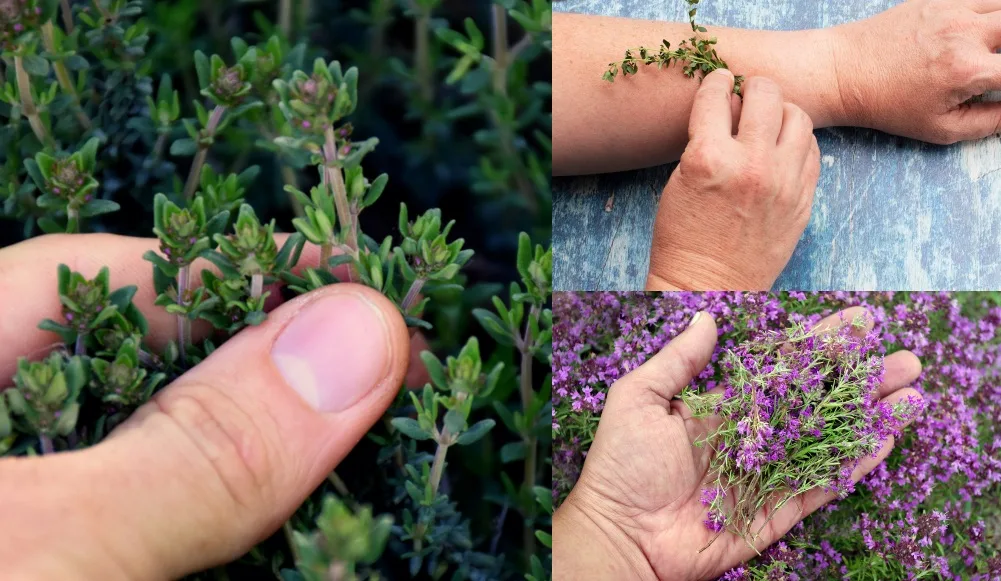
One of my favorite scents of summer is thyme.
I love the way it smells when the plant has been baking in the sun for hours, and you brush your hand across it.
The fragrance bursts in the air, and what a fragrance it is – herbal, earthy, green, and slightly medicinal.
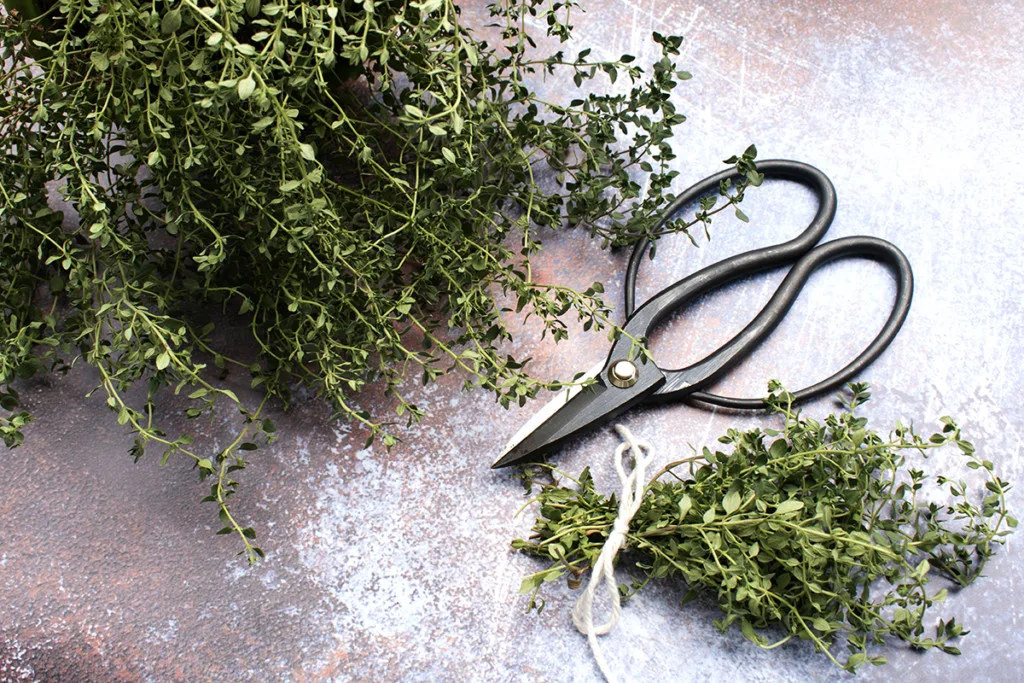
Long into the dark winter, the scent of thyme in my cooking brings to mind balmy summer afternoons.
If you don’t already have some in your garden, I recommend planting at least one variety of thyme. Its distinct flavor is used in so many different dishes.
And thyme is a useful plant beyond the kitchen as well.
There are many different varieties from creeping thyme to lemon thyme to woolly thyme. All of them are generally compact; many grow low to the ground and make an excellent ground cover.
This woody little plant is an excellent herb for the beginning herb gardener because it thrives with a little neglect. Thyme is forgiving of being underwatered and over pruned.
Thyme is a popular cooking herb, and for good reason.
This easy to grow plant pairs well with so many foods, both savory and sweet. You can pick the leaves from the plant or add the entire stem, and it’s a must-have when making an herbal bouquet to add to a roasted chicken or soup.
Use thyme to flavor meats, especially lamb and chicken. Toss it in with eggs. Add a pinch to a biscuit or bread dough. Thyme is great in cheesy dishes. And most soups and stews just wouldn’t be the same without thyme.
When you’re using thyme in a recipe, keep in mind that it should be added early on in the cooking process. Thyme is slow to release its oils, so it needs plenty of time to impart flavor to the dish.
When cooking, you usually measure thyme in teaspoons or sprigs. A sprig is generally considered a stem between 4-6” long. (Remove the woody stem after cooking, as most of the leaves will have fallen off by then.)
Thyme is easy to dry and keeps well when stored in an airtight container. Check out our guide on how to dry herbs.
There are so many ways to use this wonderful plant beyond tossing its leaves in a pot. Read on for some excellent uses for this herb garden staple.
A note – the suggestions provided here are for informational purposes only. Whenever choosing to use an herb for medicinal purposes, internally or topically, it is extremely important to discuss your options with your doctor first, especially if you’re pregnant, nursing, elderly or immunocompromised.
1. Herbed Butter
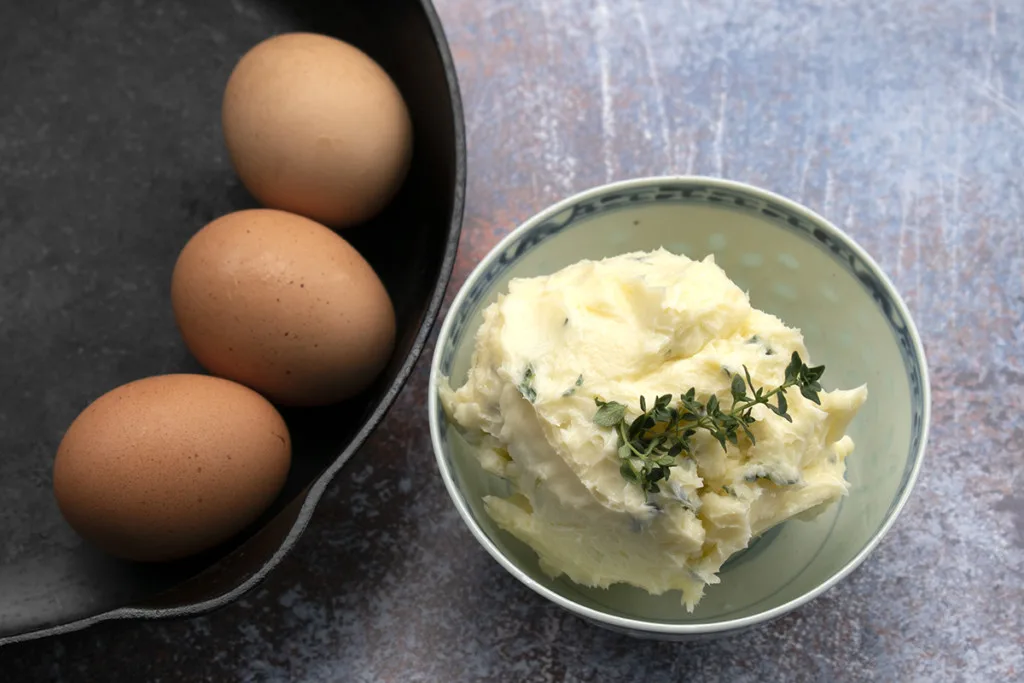
Yes, you can simply add thyme to whatever you’re cooking. But when you whip herbs into butter, something magical happens – the scent and flavor infuse the butter.
Thyme is an especially good herb to add to butter because of how long it takes the leaves to release their oils in cooking.
Cooking with thyme-herbed butter means you can add a pat at any stage and get the warmth of thyme in any dish.
Take scrambled eggs; for instance, they cook so fast that using thyme leaves wouldn’t leave you with very flavorful eggs. However, if you use thyme butter to cook your eggs in, you’ll end up with a delicious plate of scrambled eggs.
Using a mixer, whisk one teaspoon of dried or two teaspoons of fresh thyme leaves into a cup of butter (why not make your own butter?). Beat until the thyme is mixed throughout, and the butter is light and spreadable. Keep your thyme butter refrigerated and use within two weeks.
2. Thyme Simple Syrup
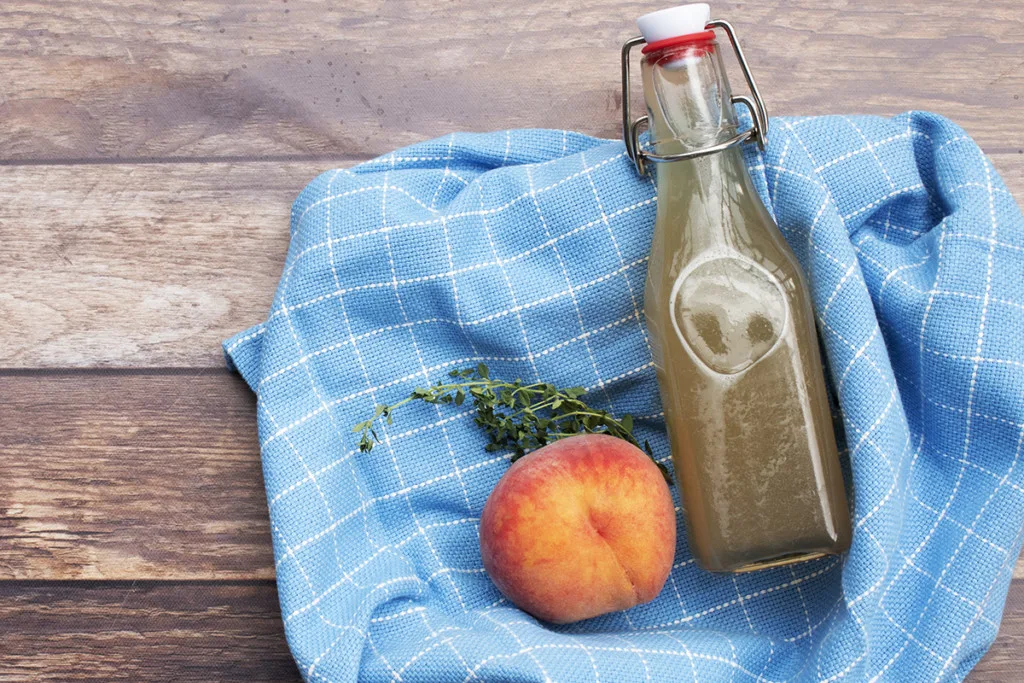
Thyme is one of my favorite herbs to make into a simple syrup. You’d be surprised at how wonderful its flavor is with sweet dishes.
Make up a batch of our thyme-infused simple syrup and add it to fresh-squeezed lemonade. Add a splash to sorbet or homemade popsicles.
Thyme pairs exceptionally well with fresh blackberries. Cherries and raspberries go well with the slightly astringent and earthy taste of thyme too.
Keep a batch of this syrup ready to hand, and I’m sure you’ll find even more tasty pairings.
3. Thyme Infused Oil or Vinegar
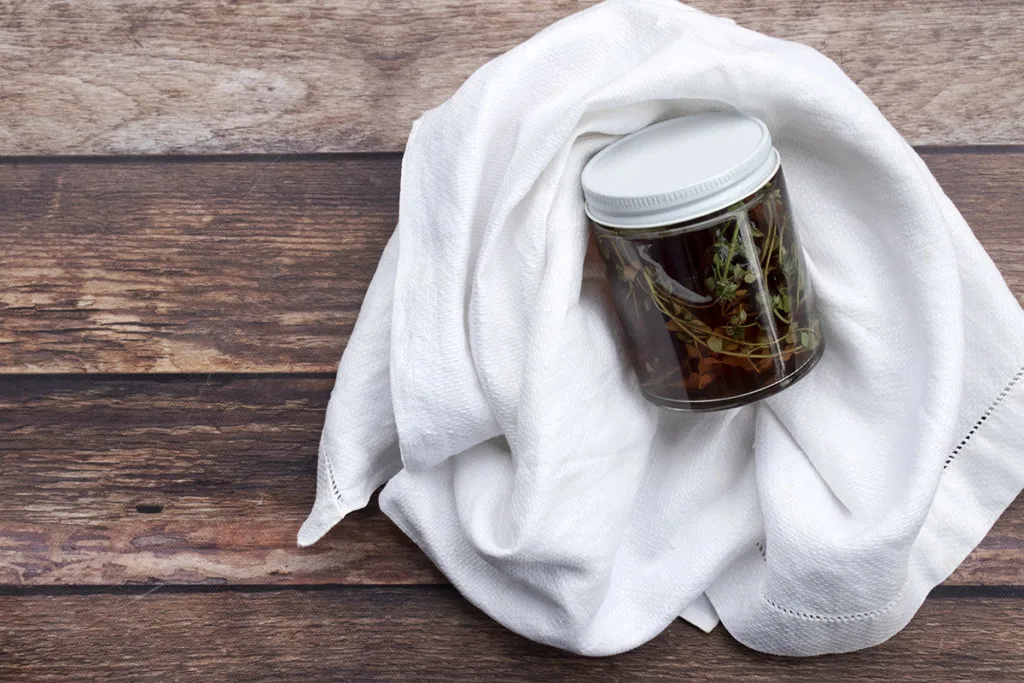
Another fantastic option to add thyme flavor to dishes is by infusing it in either oil or vinegar. White or red wine vinegar are both perfect options for a thyme-infused vinegar.
When infusing oils for cooking, it’s best to use a relatively neutral-flavored oil such as sunflower seed, canola, or grapeseed oil.
Use a jar with a lid and add 5-10 thyme sprigs, rinsed and dried, to one cup of your choice of oil or vinegar. Cap the jar and store the infusion in a warm dark place. The thyme oil or vinegar will be ready to use in a week or two.
Vinegars will keep for up to two months, and oils will keep, refrigerated, for up to a month.
4. Make Thyme Tea
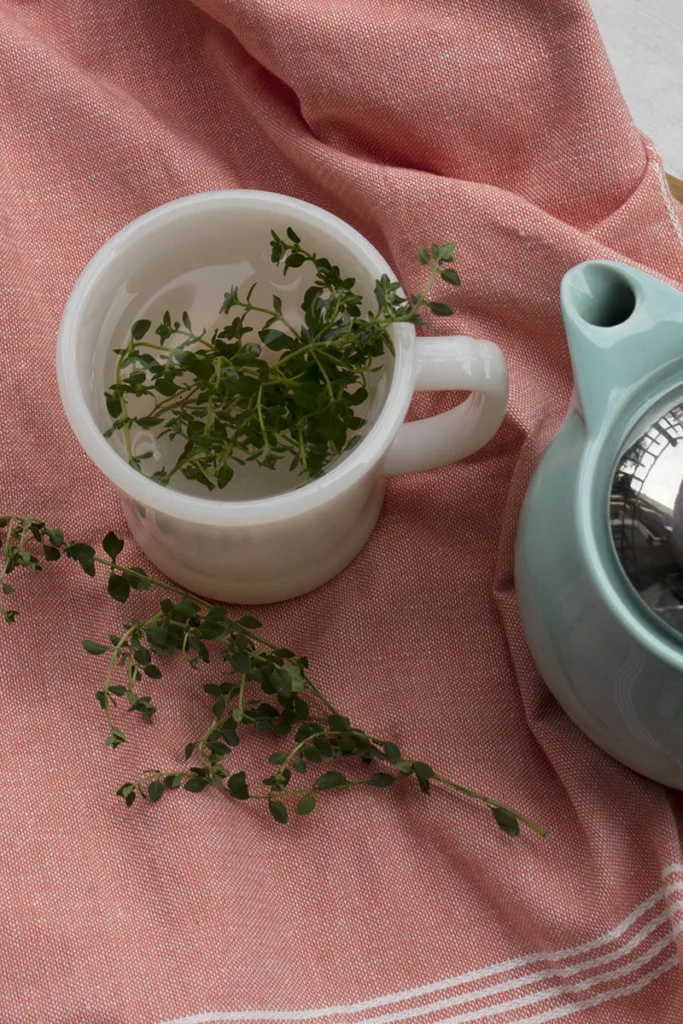
A cup of thyme tea? You bet. It’s warm and comforting and may offer some health benefits, like making a cough more productive, alleviating a headache, or giving you more clarity and focus.
Drinking thyme tea will settle your stomach after a heavy meal. Try a cup at bedtime to help soothe and relax you before sleeping. Lemon thyme makes an especially good cup of tea.
To enjoy a cup of thyme tea, pour 8 oz. of boiling water over two or three sprigs of fresh thyme. Allow the tea to steep for 10-15 minutes. Enjoy!
Read Next: 18 Plants To Grow In Your Herbal Tea Garden
5. Infused Massage or Skin Oil
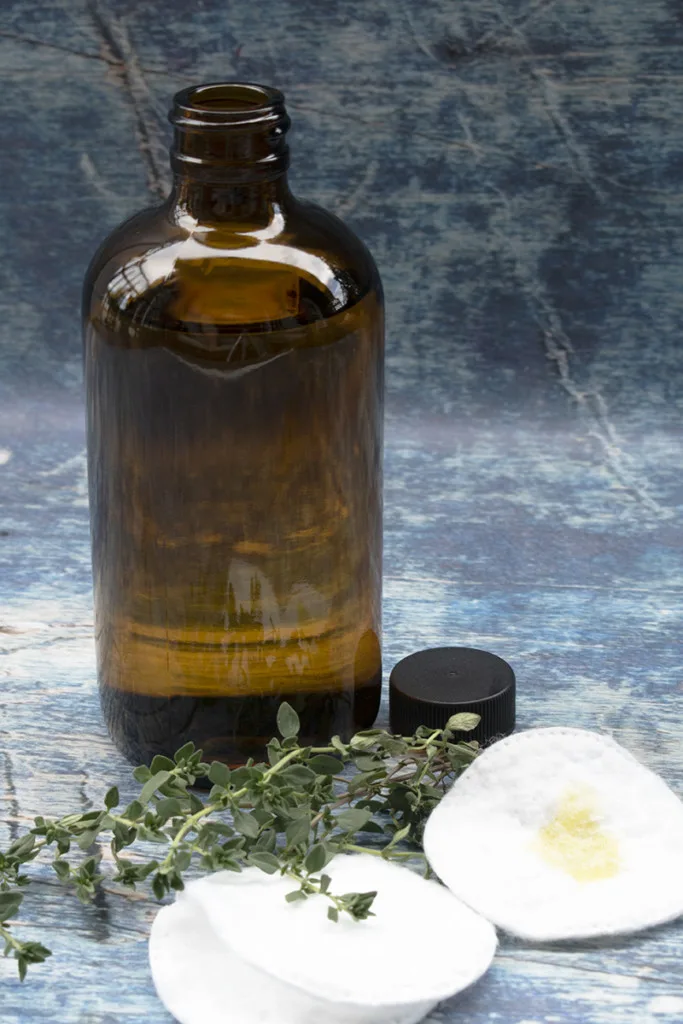
Infuse a carrier oil such as jojoba or apricot seed oil with fresh thyme.
Use the resulting oil as an invigorating massage oil. Rub a drop or two on your temples to alleviate headaches or to boost concentration. Add a few drops to a diffuser to lift your mood. Mix a teaspoon into a cup of witch hazel and use it as a toner to help clear your skin of acne. Rub the oil on your scalp before shampooing to alleviate itchy skin and to help clear dandruff.
Add 5-10 sprigs of rinsed and dried thyme to one cup of your choice of carrier oil. Keep in a sealed jar, someplace warm and dark for two weeks. Shake occasionally. Strain the oil into a clean and sterile jar. Use within two weeks, or keep it in the refrigerator for up to a month.
6. Congestion Relief
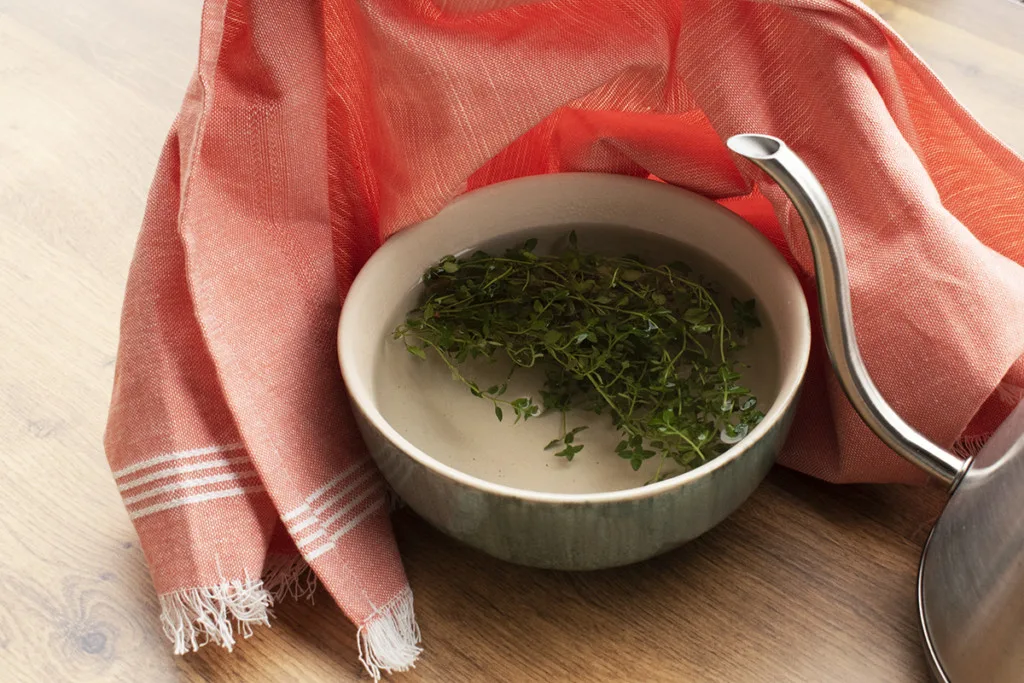
Enjoy a steamy facial that opens your airways and makes coughs more productive.
Add a handful of fresh thyme sprigs to a bowl of hot water. Place a towel over your head and around the bowl and carefully and slowly breathe in the moist, thyme-scented air. The warm air and thymes natural expectorant properties will help break up the gunk in your head and lungs.
You might also try adding a drop or two of thyme-infused oil to a diffuser and sleeping with it by your bedside.
7. Natural Moth Repellent
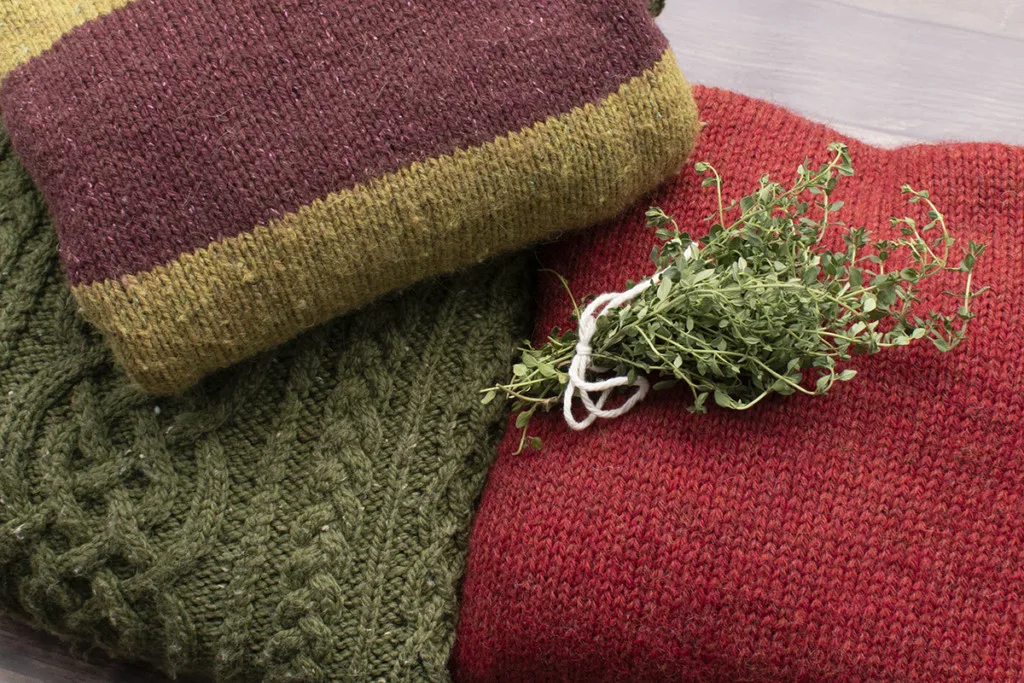
Thyme’s signature scent also repels the types of moths that like to chew up your clothes.
Hang a bundle of fresh thyme in your closet. Or place a few sprigs in your dresser drawers. Use it in a mix with other pest-repelling herbs to make sachets that will leave your clothes hole-free and smelling wonderful.
8. Thyme Scented Soap
Do you make your own soap? Add dried thyme to a batch of soap for an invigorating soap that will help with headaches, boost mental clarity, and help you jump start your day.
The natural antibacterial and antifungal properties of thyme may even help with skin conditions like acne or dandruff.
9. Keep Mosquitoes at Bay

Gently rub thyme leaves over your arms and clothing. The crushed leaves will release their oils and keep mosquitoes away.
10. Use Thyme as Pest Control in Your Garden
Let thyme plants pull double duty by planting it near tomatoes and cabbages. The powerful scent of this herb repels common garden pests like carrot flies, cabbage loopers, and tomato hornworms.
You’ll enjoy plenty of this wonderful seasoning for the kitchen while providing a valuable companion plant.
This useful plant is sure to be a welcome addition to any garden. And after reading this list, you may decide that one plant isn’t enough. I hope thyme will find its way into your garden this year.

Get the famous Rural Sprout newsletter delivered to your inbox.
Including Sunday musings from our editor, Tracey, as well as “What’s Up Wednesday” our roundup of what’s in season and new article updates and alerts.

